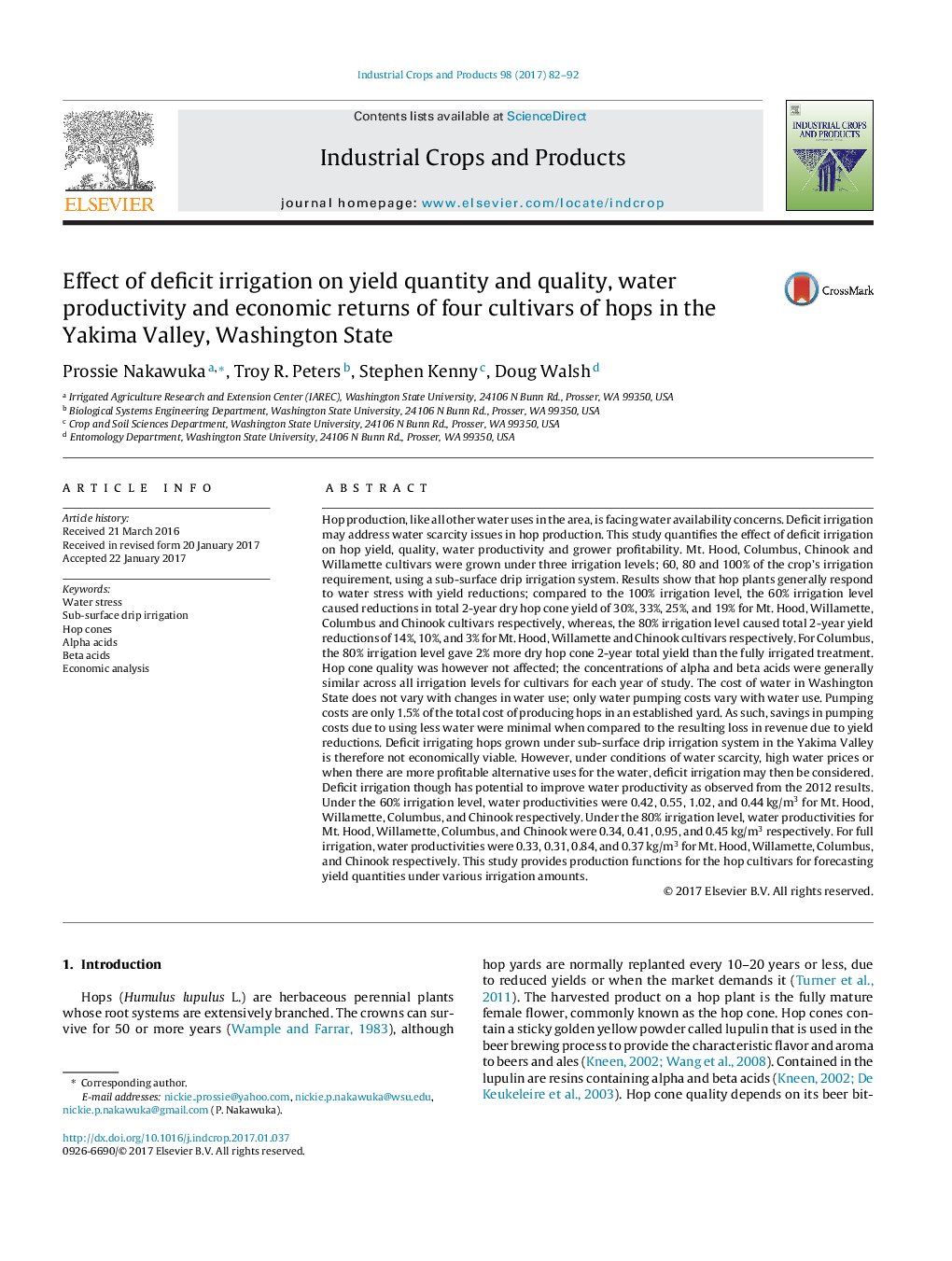| کد مقاله | کد نشریه | سال انتشار | مقاله انگلیسی | نسخه تمام متن |
|---|---|---|---|---|
| 5762202 | 1624812 | 2017 | 11 صفحه PDF | دانلود رایگان |
عنوان انگلیسی مقاله ISI
Effect of deficit irrigation on yield quantity and quality, water productivity and economic returns of four cultivars of hops in the Yakima Valley, Washington State
ترجمه فارسی عنوان
تاثیر آبیاری کسر بر کیفیت و کارآیی آب، بهره وری آب و بازده اقتصادی چهار رقم هپس در دره یکیما، واشنگتن
دانلود مقاله + سفارش ترجمه
دانلود مقاله ISI انگلیسی
رایگان برای ایرانیان
کلمات کلیدی
تنش آبی، آبیاری قطره ای زیر سطح، مخروط هاپ، اسیدهای آلفا، اسید بتا، تحلیل اقتصادی،
موضوعات مرتبط
علوم زیستی و بیوفناوری
علوم کشاورزی و بیولوژیک
علوم زراعت و اصلاح نباتات
چکیده انگلیسی
Hop production, like all other water uses in the area, is facing water availability concerns. Deficit irrigation may address water scarcity issues in hop production. This study quantifies the effect of deficit irrigation on hop yield, quality, water productivity and grower profitability. Mt. Hood, Columbus, Chinook and Willamette cultivars were grown under three irrigation levels; 60, 80 and 100% of the crop's irrigation requirement, using a sub-surface drip irrigation system. Results show that hop plants generally respond to water stress with yield reductions; compared to the 100% irrigation level, the 60% irrigation level caused reductions in total 2-year dry hop cone yield of 30%, 33%, 25%, and 19% for Mt. Hood, Willamette, Columbus and Chinook cultivars respectively, whereas, the 80% irrigation level caused total 2-year yield reductions of 14%, 10%, and 3% for Mt. Hood, Willamette and Chinook cultivars respectively. For Columbus, the 80% irrigation level gave 2% more dry hop cone 2-year total yield than the fully irrigated treatment. Hop cone quality was however not affected; the concentrations of alpha and beta acids were generally similar across all irrigation levels for cultivars for each year of study. The cost of water in Washington State does not vary with changes in water use; only water pumping costs vary with water use. Pumping costs are only 1.5% of the total cost of producing hops in an established yard. As such, savings in pumping costs due to using less water were minimal when compared to the resulting loss in revenue due to yield reductions. Deficit irrigating hops grown under sub-surface drip irrigation system in the Yakima Valley is therefore not economically viable. However, under conditions of water scarcity, high water prices or when there are more profitable alternative uses for the water, deficit irrigation may then be considered. Deficit irrigation though has potential to improve water productivity as observed from the 2012 results. Under the 60% irrigation level, water productivities were 0.42, 0.55, 1.02, and 0.44Â kg/m3 for Mt. Hood, Willamette, Columbus, and Chinook respectively. Under the 80% irrigation level, water productivities for Mt. Hood, Willamette, Columbus, and Chinook were 0.34, 0.41, 0.95, and 0.45Â kg/m3 respectively. For full irrigation, water productivities were 0.33, 0.31, 0.84, and 0.37Â kg/m3 for Mt. Hood, Willamette, Columbus, and Chinook respectively. This study provides production functions for the hop cultivars for forecasting yield quantities under various irrigation amounts.
ناشر
Database: Elsevier - ScienceDirect (ساینس دایرکت)
Journal: Industrial Crops and Products - Volume 98, April 2017, Pages 82-92
Journal: Industrial Crops and Products - Volume 98, April 2017, Pages 82-92
نویسندگان
Prossie Nakawuka, Troy R. Peters, Stephen Kenny, Doug Walsh,
